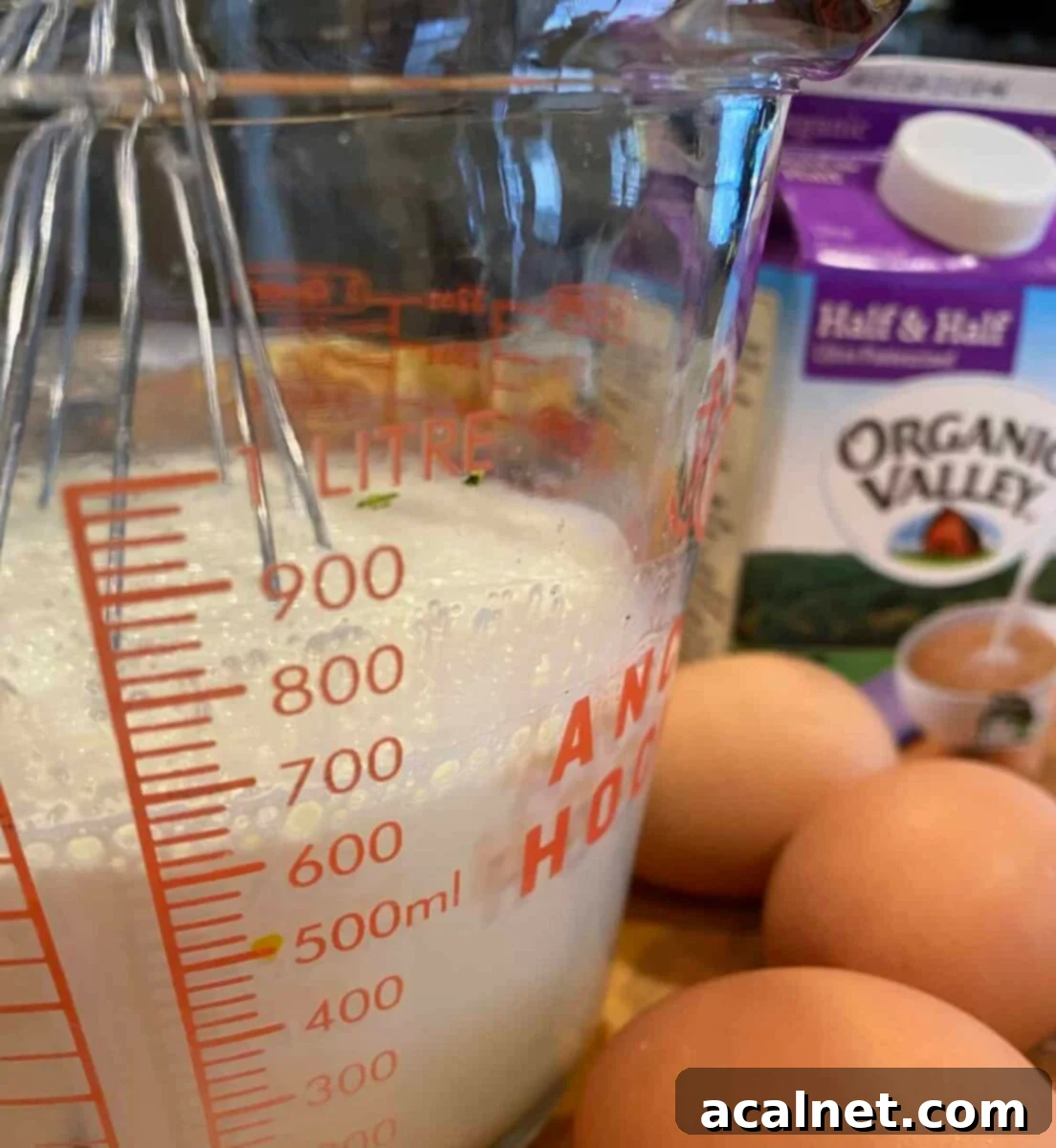Ultimate Decadent Croissant Bread Pudding: An Easy Recipe with Buttery Flakes & Fresh Fruit
Croissant Bread Pudding is truly a culinary masterpiece, effortlessly combining the rich, buttery flakiness of fresh croissants with the vibrant sweetness of fresh fruit and a sumptuously smooth vanilla custard. This isn’t just a dessert; it’s an experience, a delightful fusion of textures and flavors that will tantalize your taste buds. What makes this bread pudding recipe even more exceptional is its incredible versatility – it’s equally delicious whether served warm straight from the oven or chilled as a refreshing treat. The best part? You can have it assembled and ready for baking in less than 15 minutes, making it a perfect choice for both impromptu gatherings and planned celebrations. For an extra layer of indulgence, consider serving it with a dollop of Homemade Honey Butter, which creates a truly unforgettable flavor combination that complements the rich croissants beautifully.

🥐 Essential Ingredients for Croissant Bread Pudding
Creating this irresistible Croissant Bread Pudding is surprisingly simple, requiring only a handful of readily available ingredients. The beauty of this recipe lies in its elegant simplicity. You’ll need store-bought croissants, fresh fruit of your choice, and a few pantry and refrigerator staples. Each ingredient plays a crucial role in building the dish’s incredible depth of flavor and texture, from the airy flakiness of the croissants to the creamy richness of the custard.
- Croissants: The star of the show! Use day-old croissants if possible, as they absorb the custard better, but fresh ones work beautifully too. The buttery layers are key to the pudding’s unique texture.
- Half-and-half: This provides the perfect balance of richness and creaminess for our custard, without being overly heavy like heavy cream. It contributes to the luxurious mouthfeel of the final dish.
- Eggs: Essential for binding the custard and giving it structure, ensuring a smooth, silky consistency that envelops the croissant pieces.
- Sugar: Sweetens the custard to perfection, balancing the tartness of the fruit and the richness of the croissants. Adjust to your preference.
- Vanilla extract: A classic flavor enhancer that adds warmth and depth to the vanilla pudding, making it incredibly aromatic and comforting.
- Fresh fruit: Adds a burst of natural sweetness, a touch of tartness, and beautiful color. Berries are a popular choice, but feel free to experiment with other soft fruits (more on this below!).
While this Croissant Bread Pudding is a delightful stand-alone dessert, it also makes an exquisite addition to any brunch spread. For a savory counterpoint that perfectly complements its sweetness, consider pairing it with a cheesy delight like my Cougar Gold Quiche or a hearty Green Chili Egg Casserole. The contrast between sweet and savory will elevate your brunch to new heights.
For precise measurements and a full list of ingredients, please scroll down to the comprehensive recipe card below.

💭 Step-by-Step Guide: Crafting Your Croissant Bread Pudding
You’ll be amazed at how quickly this elegant dessert comes together. The hands-on prep time for this Croissant Bread Pudding is incredibly minimal – you can have the croissants diced and the sweetened half-and-half mixture poured over them in fewer than 15 minutes! The real “work” happens in the oven, transforming simple ingredients into a golden, custardy delight.
Here’s a detailed, step-by-step guide to assembling your delicious bread pudding:
- Prepare the Custard Mixture: In a large 4-cup glass measuring cup or a mixing bowl, combine the half-and-half, granulated sugar, vanilla extract, and eggs. Whisk vigorously until all ingredients are thoroughly combined and the mixture is smooth. This ensures an even distribution of sweetness and flavor throughout your custard.
- Dice the Croissants: Using a sharp knife, cut each croissant into bite-sized pieces, roughly 1 to 1.5 inches. Don’t worry about perfect uniformity; varying sizes can add interesting texture to the pudding. The goal is to create pieces that can easily absorb the custard.
- Prepare the Fresh Fruit: Gently rinse your chosen fresh fruit under cool water. Place it in a colander and allow it to drain completely. Patting softer fruits like berries dry with a paper towel can help prevent excess moisture in the pudding.
- Layer the Ingredients: Lightly butter or spray a 9″ x 9″ baking dish with non-stick cooking spray. Arrange half of the diced croissants evenly across the bottom of the dish. Scatter half of the prepared fresh fruit over the croissant layer.
- Add Second Layer: Top with the remaining diced croissants, ensuring they are spread out. Then, sprinkle the rest of the fresh fruit over this second layer. This layering technique ensures fruit and croissant goodness in every bite.
- Pour the Custard: Carefully pour the whisked half-and-half mixture evenly over the layers of croissants and fruit. Make sure to saturate as many pieces as possible. Allow the dish to rest for at least 30 minutes (or cover and refrigerate overnight) so the croissants can fully absorb the liquid. This crucial step prevents a dry bread pudding!
While this Croissant Bread Pudding is a star on its own, it also pairs wonderfully with a variety of savory dishes, especially for a brunch menu. If you’re looking for something savory to serve alongside its delightful sweetness, I highly recommend my Cranberry Jalapeno Meatballs for a unique sweet-and-spicy kick, or my popular Starbucks Copycat Egg Bites for a protein-packed option.
⏲️ Choosing the Right Baking Dish for Success
The choice of your baking dish can subtly influence the outcome of your Croissant Bread Pudding. When you are assembling the dish, layering the diced croissants and fresh fruit, it will appear quite full in a standard 9″ x 9″ baking dish. This is perfectly normal and actually ideal, as it helps create that satisfying density and structure in the finished pudding. However, if you opt for a larger dish, such as a 9″ x 13″ pan, keep in mind that this will significantly affect the baking time, as the layers will be thinner and heat more quickly. If you do use a larger baking dish, be sure to check for doneness much earlier, typically after just 25 minutes, to prevent overbaking.
Pro Tip: For this recipe, I find that glass bakeware yields the best results. Glass conducts heat evenly and allows you to visually monitor the browning of the pudding and the bubbling of the custard, ensuring it’s cooked through but not burnt. Here’s a fantastic glass baking dish that I personally recommend for its durability and even heat distribution, but any 8″ x 8″ or 9″ x 9″ baking pan made of glass, ceramic, or metal will work wonderfully. Just remember to adjust baking times as needed!
🥣 The Magic of the Croissant Pudding Base
One of the most enchanting aspects of this recipe is how the simple liquid ingredients transform into a delicate, custardy base at the bottom of the dish. When you pour the sweetened half-and-half mixture over the layers of diced croissants and fresh fruit in the baking dish, you’ll notice it perfectly saturates the bread without completely submerging every piece. This strategic balance is key.
During the baking process, as the croissants on top toast to a golden, slightly crisp perfection, the rest of the liquid gently settles to the bottom. Here, it bakes into a tender, sweet, and incredibly delicate layer that is remarkably similar to a traditional pudding or custard. This creates a delightful contrast between the flaky top and the creamy, luscious base. Indeed, you could proudly call it a “croissant pudding,” and no one would argue, as it truly embodies the best qualities of both a bread pudding and a classic custard dessert.

⭐ Recipe Frequently Asked Questions
For the best flavor and texture, this croissant bread pudding is ideally served within two days of baking. To store any leftovers, allow the pudding to cool completely to room temperature. Then, cover the baking dish tightly with plastic wrap or transfer individual portions to an airtight container. Always store it in the refrigerator. Remember, because there’s a luscious pudding-like custard layer along the bottom of the dish, these dairy and egg-based ingredients necessitate refrigeration, even after baking, to maintain freshness and safety.
Technically, yes, you can freeze bread pudding, but in my opinion, Croissant Bread Pudding truly shines when served either warm from the oven on the day you bake it or delightfully cold straight from the refrigerator. If you do choose to freeze it, ensure the bread pudding has cooled completely. Cover the dish tightly with at least two layers of foil to prevent freezer burn. It can be frozen for up to three months. To reheat, thaw it in the refrigerator overnight (about 8-10 hours). Remove it from the fridge approximately 45 minutes before baking to allow it to come closer to room temperature. Leave the foil on top and reheat in a 350° F (175°C) oven for about 15-20 minutes, or until warmed through. You can remove the foil for the last few minutes if you desire a crisper top.
Absolutely! While croissants offer a unique buttery flavor and flaky texture that truly elevates this particular bread pudding, you can certainly experiment with other types of rich, egg-based breads. Excellent alternatives include brioche or challah bread. However, it’s important to note that neither brioche nor challah will provide the exact same buttery richness or delicate flakiness inherent in croissants. As a result, using these substitutions will typically result in a bread pudding that is somewhat denser and has a different, though still delicious, texture. If you’re looking for a similar decadent feel, ensure your chosen substitute is also soft and slightly sweet.

Yes, this recipe is perfect for making ahead! You can assemble the entire dish, including layering the croissants and fruit and pouring the custard over it, then cover it tightly with plastic wrap and refrigerate it overnight. This allows the croissants ample time to soak up all the delicious custard, ensuring an incredibly moist and flavorful pudding. Just remember to take it out of the refrigerator about 30 minutes before baking to let it come to room temperature, and you might need to add a few extra minutes to the baking time.
For optimal results, slightly stale or day-old croissants are often preferred for bread pudding because they are drier and absorb the custard mixture more effectively, leading to a richer, moister interior. However, fresh, buttery croissants also work beautifully, contributing to a more tender and delicate texture. Feel free to use plain butter croissants; avoid any filled or glazed varieties as they can alter the flavor profile of the pudding.
👩🏻🍳 Fruit: An Optional, Yet Delightful, Addition
While this recipe specifically calls for a generous 1 ½ cups of fresh berries, I want to assure you that I’ve prepared this Croissant Bread Pudding numerous times without any added fresh fruit, and the result is consistently just as delicious and satisfying. The decision to include fruit truly comes down to personal preference and what you’re craving.
When you do incorporate unsweetened fresh berries, they provide a wonderful contrast. Their natural tartness and juicy burst of flavor cut through the richness of the buttery croissants and the sweet vanilla custard. This creates a beautifully balanced taste profile that is both refreshing and indulgent. The vibrant colors of the fruit also add an appealing visual element to the dish, making it even more inviting.
But rest assured, whether you’re a purist who prefers the unadulterated buttery goodness of croissants and custard, or someone who loves the bright notes of fruit, this is a dessert (or brunch) recipe that is guaranteed to be enjoyed by all. Don’t let the absence of fruit stop you from making this incredible treat!

🔪 Optimizing Croissant Size for the Perfect Bread Pudding
The type and size of croissants you choose can subtly influence the final texture and appearance of your bread pudding. I’ve experimented with both standard-sized, large croissants and much smaller mini-croissants, and each offers a slightly different experience. While both work well, there’s a specific reason why I often lean towards the smaller variety.
Pro Tip: I personally prefer using the smaller, mini-croissants for this recipe. The reason is simple: when you use 12 mini-croissants instead of just six standard-sized, large croissants, you end up with a greater number of those deliciously sturdy, slightly crisp croissant tips dispersed throughout the bread pudding. These tips provide delightful pockets of concentrated buttery flavor and a lovely textural contrast to the softer, custard-soaked interiors, elevating the overall eating experience.
Furthermore, this recipe is an excellent way to use up croissants that might be a day or two old and starting to dry out. Most grocery stores sell large packages of croissants, and they do tend to lose their fresh softness quickly. If you find yourself with a few extra croissants that are past their prime for eating plain, this recipe is a fantastic and flavorful way to ensure that no delicious croissant goes to waste. It’s a win-win: you get to enjoy a decadent dessert, and you reduce food waste!

🍓 Diverse Fruit Options for Your Croissant Bread Pudding
One of the joys of making this Croissant Bread Pudding is the flexibility it offers when it comes to fruit. You can easily mix and match fresh fruits to suit your taste or what’s in season. The key to successful fruit incorporation is selecting varieties that don’t require extensive cooking to soften, allowing them to remain tender and juicy within the pudding.
For fruits with skins like peaches and apricots, it’s a good idea to peel them first to ensure a smooth texture in the finished pudding. After peeling, simply slice and dice them into small, uniform, bite-sized portions so they blend seamlessly with the croissants and custard. Here’s an expanded list of fruits that will work beautifully in your croissant bread pudding, offering a range of flavors and colors:
- Raspberries: Offer a delightful tartness and vibrant color, bursting with juicy flavor.
- Blueberries: Small, sweet, and firm enough to hold their shape, providing subtle pops of flavor.
- Blackberries: Larger and slightly tarter than blueberries, they add a robust berry flavor.
- Strawberries: Slice larger strawberries into quarters or halves to ensure even distribution and easier eating. Their sweetness is always a crowd-pleaser.
- Peaches: When ripe, they become incredibly sweet and tender. Remember to peel and dice them for the best texture.
- Apricots: Similar to peaches, these stone fruits offer a delicate sweetness and beautiful golden hue when peeled and diced.
- Cherries: Pit and halve fresh cherries for a sophisticated and slightly tart addition.
- Mixed Berries: A combination of raspberries, blueberries, and sliced strawberries offers a complex and appealing flavor profile.
♨️ A Decadent Dish That Needs No Extra Sauce
Unlike many traditional bread puddings that often call for a rich, syrupy sauce drizzled generously over each serving, this Croissant Bread Pudding truly stands on its own without needing any additional embellishments. While I’m certainly never one to decline an opportunity to add more sweetness or richness to a dessert, in this particular case, the pudding itself is so perfectly balanced and incredibly flavorful that an extra sauce would simply be superfluous.
The inherent richness from the buttery croissants, combined with the creamy, sweetened vanilla custard and the natural sweetness of the fresh fruit, already provides a complete and satisfying taste experience. There is plenty of sugary sweetness and decadent moisture embedded within the dish, ensuring every bite is moist, flavorful, and utterly delightful. You’ll find that the delicate layers and the interplay of textures are enough to impress without a heavy topping.
Pro Tip: If you wish to add a touch of elegance or a subtle visual flourish, sometimes, just to be fancy, I’ve dusted each serving of Croissant Bread Pudding with a light sprinkling of powdered sugar just before serving. The fine white sugar provides a beautiful contrast against the golden-brown top. For an extra pop of color and freshness, placing a small sprig of fresh mint on the side of the plate adds a professional, gourmet touch and a subtle aromatic hint that complements the fruit beautifully.
🍴 The Enduring History and Evolution of Bread Pudding
Bread pudding has a fascinating and humble history, tracing its origins back to England in the 11th and 12th centuries. In those early days, it wasn’t considered a gourmet dessert but rather a resourceful way to utilize stale or leftover bread, ensuring that precious food didn’t go to waste. Known as “poor man’s pudding” or “waste bread pudding,” it was a testament to culinary frugality, combining old bread with whatever dairy, eggs, and sweeteners were available to create a comforting and filling meal.
Fast forward to today, and bread pudding has undergone a remarkable transformation. It has shed its humble origins to become a beloved and often sophisticated standalone treat, featured on menus of fine dining establishments and cherished in home kitchens around the world. Modern variations, like our Croissant Bread Pudding, elevate the concept by using premium ingredients, turning a simple leftover dish into a decadent, sought-after delicacy. This evolution highlights how a clever, practical solution born out of necessity can transcend time and become a culinary classic enjoyed for its sheer deliciousness.
So, a heartfelt hat tip to all those resourceful bakers of yesteryear who, with their ingenuity, came up with such a brilliant way to combine bread with a sweetened custardy pudding, resulting in a dish that continues to delight generations with its deliciousness and comforting warmth.
Pro Tip: Speaking of making sure no ingredients ever go to waste, don’t miss out on another fantastic recipe for utilizing ripe produce. Be sure to check out my Crockpot Banana Bread recipe. It offers a whole new, incredibly convenient spin on slow cooker baking and is a truly ingenious way to transform those overripe bananas into a moist, flavorful loaf with minimal effort.

🍰 More Delectable Dessert Ideas to Satisfy Your Sweet Tooth
If you love using fresh fruit to create vibrant and delicious desserts, just as we do with this Croissant Bread Pudding, then you’ll definitely want to explore some of my other favorite recipes. Give these a try and let me know what you think – I’m always thrilled to hear your feedback!
- My Fresh Fruit Tart features a perfectly buttery shortbread crust that is simply divine, topped with a colorful array of seasonal fruits.
- For chocolate and berry lovers, the Chocolate Strawberry Pie recipe is a must-try. It’s designed for making adorable mini-pies, and they are especially good when fresh, ripe strawberries are in season and plentiful.
- The No-Peel Apple Cake stands out as one of the easiest apple spice cake recipes you’ll ever encounter. We even keep the peels on the apples for extra flavor and nutrients, making prep a breeze!
🥧 Explore More Irresistible Baking Recipes
Beyond desserts, my kitchen is always buzzing with new and classic baking projects. Whether you’re looking for a hearty breakfast, a comforting snack, or another sweet treat, you’ll find plenty to inspire you here:
- Homemade Biscuits (Easy, No Yeast Recipe)
- Chocolate Zucchini Cake
- Candy Cane Cookies
- Tiramisu Cake for Dessert
If you made Croissant Bread Pudding or any other recipe on my website, please leave a 🌟 star rating and let me know how it goes in the 📝 comments below. Your feedback helps other home cooks discover and enjoy these recipes!
Recipe Card

Croissant Bread Pudding
Ingredients
- 6 croissants – large – or 12 mini-croissants
- 2 cups half-and-half
- 1 cup sugar
- ½ teaspoon vanilla extract
- 3 eggs
- 1 cup raspberries – fresh
- ½ cup blueberries – fresh
Instructions
- Butter a 9″ x 9″ glass baking dish or spray with Pam.
Dice Croissants and Prep Ingredients
- Slice and cut croissants into bite-sized pieces and set aside. In a large, 4-cup glass measuring cup add half-and-half, sugar, vanilla extract and eggs. Whisk to combine.
- Place ½ the croissants in a baking dish and top with half of the fruit, creating a first layer. Next, place what’s left of the croissants and fruit on top of that first layer. Pour the liquid from the measuring cup over the diced croissants and fruit. Set aside and allow the dish to rest for 30 minutes or cover with plastic wrap and refrigerate overnight.Note: If refrigerating overnight, remove the baking dish from the refrigerator in the morning and set it on the kitchen counter at room temperature for 30 minutes before baking. Remove the plastic wrap and bake as directed. Since the ingredients were chilled, it may need a few extra minutes in the oven.
Bake
- Preheat oven to 350° F.
- Bake for 30-40 minutes or until the croissants are lightly browned on top and bubbling around the edges. If baking after refrigeration, it may need a few extra minutes.
- Serve immediately. If for brunch or breakfast, enjoy with coffee or orange juice. For dessert, serve as-is or top with a dusting of powdered sugar or a dollop of whipped cream. I like to garnish with a sprig of fresh mint.
Notes
Please note, the nutrition details are estimated using a food database, so they’re just a rough estimate not an exact science.
